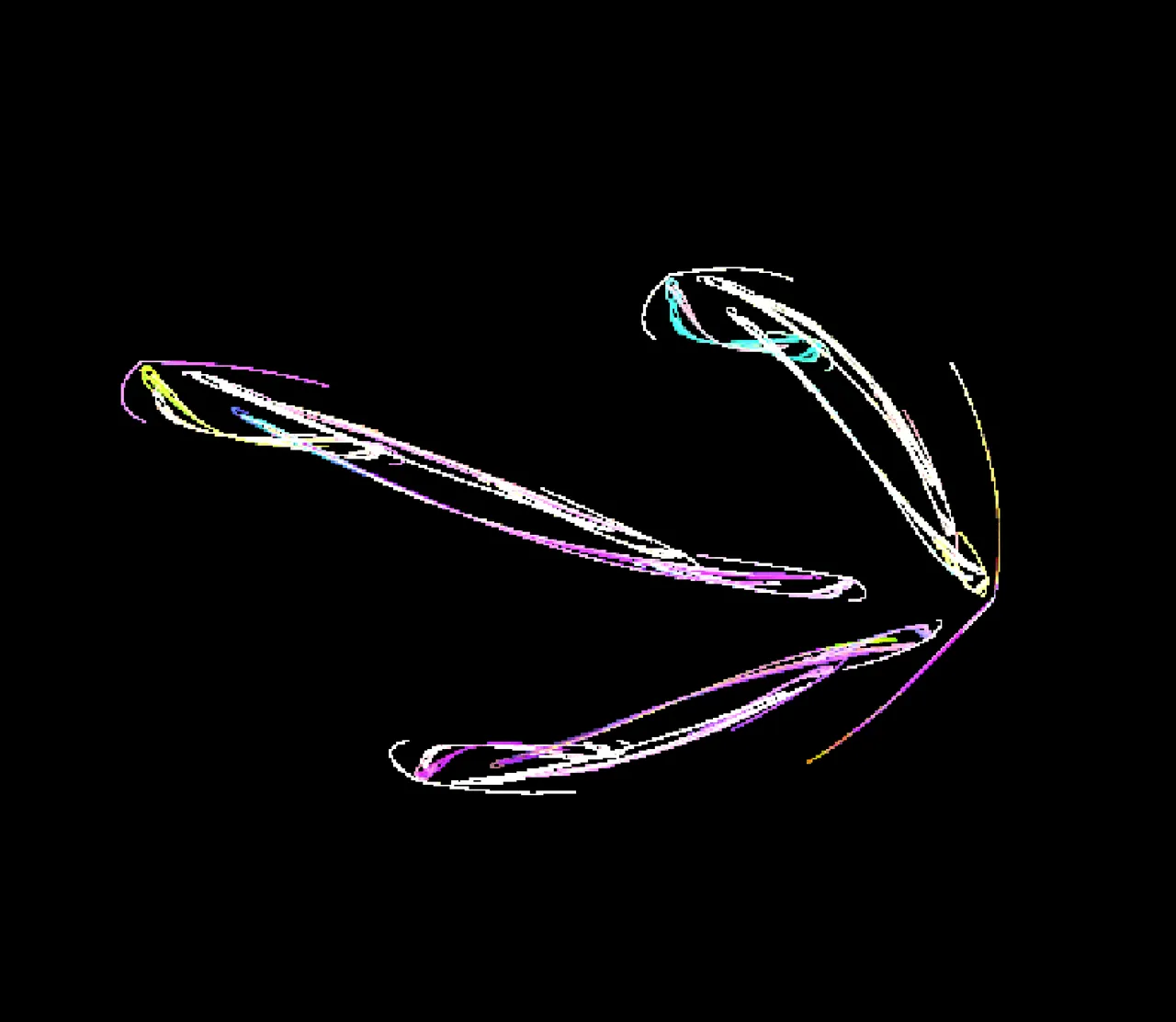
I would have slept through the one Hypahradysian movie I would have understood and enjoyed – but Vivaleshoom was a friend.
He knew, somehow – he had that much of an opinion of my intellect – that I would begin to understand if I watched the last movie of the evening, a comedy about a treasure hunt.
Cross-cultural humor is always tricky because the references were not known to most guests in a new culture, but from following the action it was not unlike such comedies on Earth – folks on a quest to find a mythical treasure, some with the intention of doing good and others with doing evil. There were all kinds of complex math jokes that I didn't catch, but the live action sequences were hilarious, so I laughed just about as hard as my new friends.
Still, the keeper of the treasure had to make a decision when both the good guys and the bad guys arrived at the same time to claim the treasure. He gave the single clue above. The bad guys screamed for joy, knocked the good guys out, and ran … the good guys eventually got up and split up to walk off in three different directions, with the Keeper smiling on them.
The last scene of the movie showed the bad guys whooping, hollering, and digging at the place the big arrow pointed to – and the narrator shouted as the screen went black, “And as far as we know, they are digging and digging still!”
All my Hypahradysian friends laughed uproariously, with the implication being that the good guys would get the treasure and the bad guys were permanently kept from it. They thought it was a great movie and were very satisfied.
I was confused.
“Help me understand,” I said to Vivaleshoom, and he smiled.
“This is why you are among the good guys of the universe, Captain Dixon,” he said. “Humility is the first requirement of everything. Look at it again … what do you see now that you know you should look for more?
That thing about reiterating arrows … Knuth and his arrow notation to handle numbers bigger than exponents could manage … Graham and his massive Graham's Number that had been the first to push the arrow iteration process to a literally unspeakable limit … it came up over and over again in fractal iteration processes, the repeating of the same operation again and again and again upon itself …
Suddenly, the arrow of understanding pierced my mind, and my mind opened up.

“There are seven clearly drawn arrows there,” I said when I regained my breath. “I mean there are more than that, but seven defining unique directions. The first big one points to a location away from which you walk on the course of the three next smallest arrows, which in turn each bring you to a location from which you bounce again and follow the last three arrows to the spot where a third of the treasure is hidden – so, the good guys followed the seven-arrow path and retrieved the entire treasure!”
“Which is why it needed not be said in the movie,” Vivaleshoom said, “and why you have figured it out, Captain Dixon, my Little Friend with the Big Mind and even Bigger Heart.”
“I'm starting to understand how this works,” I said. “These big numbers that your people use every day – you have no more calculated them all the way out than anyone else, but you are comfortable with the iterative representation of them!”
“Right, because, if you have the starter, you have the rest,” Vivaleshoom said. “The walk from the valley to the top of the slope is a series of iterated steps. It is impossible to count the steps; everyone's stride length and pattern is a little different. Every walk is an infinity of steps – in every walk, infinity meets you. But if you know how the iteration is, you have it, without ever knowing the precise number. The iteration is, in human terms, just 1 plus 1, repeated n times.
“Your Graham's Number, which to your mind is so big, is indeed very large and still incalculable in full, but that is only because it is a fixed n that we can never know. That is the bigness of it to your mind, the incalculable vastness, but it is only 3 times 3, repeated n times, and even n is some iteration of 3 times 3, because it is all powers of threes built upon each other. One of your big starship computers, if you had nothing better to do with it, could possibly compute the 256th step, but no one would do that – it is enough to represent it in some way that is manipulable and thus useful.
“The difference between my culture and yours is that we acknowledge infinity all around us and accessible to everyone at work or play, and since almost all of what you think of as big numbers are just iterations of little ones, we don't have as many big ones. Even in what you see as a 7 – how is it represented there?
“One plus three plus three more,” I said.
“Right,” Vivaleshoom said. “Now, primes are kind of big when they get large – they often can be cumbersome because they are iterations only of addition.”
“1 plus 1, iterated for the prime number minus 1 number of times,” I said. “Easy if the prime is 7. Hard if it is 20 digits or more.”
“Correct,” Vivaleshoom said. “Now there are iterations even for primes, and many of them you know of – the Mersenne Prime is one well-known to humanity, and we know of many more of them than humanity does because our idea of large numbers that can be understood as an iteration of smaller ones is much more vast. But, some random prime? Those are what we consider big numbers. Some composite numbers that are not squares that are composites of nothing but large primes – those are big numbers. They are relatively rare. Everything else – everything else – is common, and ubiquitous, and not so big.
“You humans think of how long it would take and how much space it would take to write a number out. We think, why bother? They are already written out in short form, in all Creation. We would not be able to conceive of anything that does not exist.
Consider this: every arrow points out four directions, although it presumably points at one. The joke in the movie for us is that you have to look carefully to see that the fractal gives seven directions, and that the bad guys were so full of greed that they missed even the four easy ones. But there are already four possible points.”
“Right, because to even draw an arrow requires four points.”
“And that also recalls a sequence by which you build that arrow: an angle connects three points, and that other line adds the fourth. There we have a mathematical sequence: 1, 3, 4, and the next step is....?”
“Oh, my, it is 7,” I said. “And the next is 11, so … .”
“So this is why my friends and I were rolling on the floor laughing at the end of the movie. The bad guys missed as many clues as there are in an infinite sequence of adding two terms together to get a fourth, with the beginning of the sequence defined as 1, 3, and 4 because what is on the screen is an arrow. The bad guys are literally digging into infinity, because they missed just that many clues.”
At that point, I at last got the joke and laughed hard as I thought of the hole those fellows were going to dig – and the fact that there were 4 men who had missed 7 visual clues, digging with 11 shovels available to use, and exactly 18 clods of dirt had flown into the air before the screen went black as the credits rolled …
… And then I stopped, having been struck with an even deeper thought.
“They are digging into a lost infinity, a lost eternity,” I said.
“That needed not be shown, but yes. The wicked are punished to useless reiteration, forever, and downward is their direction.”
“In ancient human lore, there is a man doomed to roll a ball to the top of a hill he will never reach,” I said. “That is the asymptotic curve that never reaches where it is going.”
“There are several comedies that use that as the punch line,” Vivaleshoom said, “for the exact same reason. A line from the Book of Books in which you are often reading has also more recently been represented in that way in a drama, for everyone closes their notebooks and turns off their computers before that curve ever gets where is going – plunging the curve into darkness. Thus, given that everything in the universe is moving on a curve, but not all things are giving or reflecting light, the concept borrowed is 'wandering stars, to whom is reserved the blackness of darkness forever.' ”
“That is the doom defined for the worst of men, who lead others astray – stars who have gone off course, burned out, dark forevermore,” I said. “And yes, in both mathematics and physics, we do see this represented.”
“When we look,” Vivaleshoom said. “There is nothing truly hidden. Think of this conversation we have had about an arrow. Everything that we have said is true.”
“So, yours is a Looking Culture,” I said. “I have heard that term used many times. Now I understand.”
“Yes, and you have been so welcomed not only because we are a hospitable people, but because you are that rare Little Looking Person that we are always glad to meet, Captain Dixon.”
Vivaleshoom was, at 24 feet tall, as much larger than me as my father had been when I was a toddler, and his youngest children were mere toddlers who had to be kept from bowling me over constantly because they were just as sweet and affectionate as they could be and were as old and as big as I was. Vivaleshoom was an affectionate father, and I wondered sometimes if he wanted to pat me on the head. But, he was a member of a Looking Culture, and recognized me as a younger man. We could not shake hands directly, but he put down his massive hand for a VERY high-five with me.
“You are familiar with the term, 'He who seeks, finds.' The Redeemer said it; we dare not gainsay it. It follows that those who look, see. You are looking, and were humble enough to check on what you saw. Now you will see much more, Captain Dixon, for the rest of your life. You are worthy. I knew that when I met you. I knew that you would look, and at last, although I know it was a stretch, at last begin to see.”
This fractal arrow in Apophysis 2.09 was a shock ... I have started a new technique, and this particular fractal yielded this fractal arrow ... and then I looked at it ... and the rest you know! For the record, there ARE at least 10 arrows hidden here in this one fractal, which gives the sequence of counting by three, starting with 1 (1, 4, 7, 10), BUT, three of those point in the direction of the bigger arrow, so only seven of the little arrows point to a unique direction, and the sequence that goes 1, 3, 4, 7, 11, 18 makes for a more interesting story!